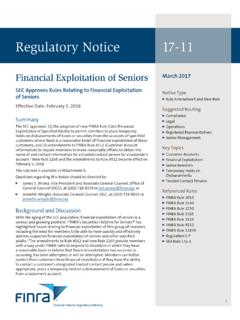Transcription of ABUSE, NEGLECT AND FINANCIAL EXPLOITATION …
1 Page 1 of 19 abuse , NEGLECT AND FINANCIAL EXPLOITATION OF THE ELDERLY AND DISABLED by Martha L. Ridgway Martha L. Ridgway, 357 South McCaslin Boulevard, Suite 200 Louisville, CO 80027 303-827-2474 303-8272462 I. INTRODUCTION1 As with other professionals who work with senior citizens, lawyers have observed a shocking increase in the incidents of abuse , NEGLECT and FINANCIAL EXPLOITATION of the elderly. Cases are brought to our attention from many different sources: the elder himself or herself, a concerned family member, friends and neighbors, social workers, adult protection workers, medical personnel, FINANCIAL institutions, senior centers and programs, clergy and even other lawyers.
2 When faced with a case of abuse , NEGLECT or FINANCIAL EXPLOITATION of an elder, the attorney can recommend and pursue a number of legal options. This paper will review the statistical realities of the aging population; define the terms abuse , NEGLECT and FINANCIAL EXPLOITATION ; identify who the most common perpetrators are; analyze why our elders are mistreated; examine what characteristics make the elderly particularly vulnerable; consider preventative drafting strategies; and address the legal remedies available to the elder and how he or she can fight back.
3 II. STATISTICAL ANALYSIS OF THE AGING POPULATION It is no secret that our population is rapidly aging. With an increasing number of elders, there are more people to victimize and greater opportunities to abuse , NEGLECT and financially exploit. Consider how the following statistics affect the incidents of abuse , NEGLECT and FINANCIAL EXPLOITATION of the elderly. It is estimated that Americans over the age of 65 years now represent approximately of the entire population.
4 This figure has more than tripled since 1900, when only of the population was age 65 or over. 1 This paper is not intended to represent formal, legal writing. Rather, while it incorporates some legal citations and principals, it is intended primarily for the purposes of disseminating information, serving as a spring board for further discussion and as providing information to assist with seeking assistance for such elders. Page 2 of 19 By the year 2050, it is estimated there will be 82 million older persons.
5 Shockingly, two-thirds of all people who have ever lived longer than 65 years are alive today. Of great significance is the fact that the older population is getting older, with those who are age 85 and over representing the fastest growing segment of the elder population. In 2000, there were approximately million people between the ages of 65 and 74, which is approximately eight times greater than a century before; those ages 75-84 ( million) were approximately 14 times greater; and those ages 85 and older ( million) were approximately 28 times greater.
6 The fact that women typically outlive men represents another factor in the increase in abuse , NEGLECT and FINANCIAL EXPLOITATION . After age 65, women increasingly outnumber men. In 2000, there were million older (age 65 and above) women compared with million older men. This represents a ratio of 143 women for every 100 men. This ratio increases with age: women typically live longer than men. Significantly, older men are much more likely to be married than are older women.
7 Not surprisingly, there are almost five times as many widows as there are widowers. Why is this country experiencing such an "age boom?" First, people are living longer. The average life expectancy in 1900 was only 47 years. Men who reach age 65 now have an average life expectancy of an additional years; women who reach age 65 now have an expectation of an additional years. Second, a large segment of our society, the "baby boomers" (those born between 1946 and 1964), are aging.
8 The oldest baby boomers turned 60 in 2006. The most rapid increases in age are expected to occur between 2010 and 2030, when this generation reaches age 65. FINANCIAL factors also contribute to abuse , NEGLECT and FINANCIAL EXPLOITATION of the elderly. The median income of persons 65 years and above in 2004 was $21,102 for men and $12,080 for women, which is not remarkable. However, in 2000, the median net worth (assets minus liabilities) of age 65 and older households was $108,885, which is well above the average of $55, In 2000, over 78% of older persons owned their homes free and clear.
9 The median value of homes for this population was $85, Medical considerations constitute another factor in abuse , NEGLECT and FINANCIAL EXPLOITATION of the elderly. Most older persons have at least one chronic condition. The most frequently occurring conditions in 2000-2001 were: hypertension ( ), arthritis ( ), heart disease (31%), cancer (20%), sinusitis ( ) and diabetes (15%). The vast majority of people age 65 and older are farsighted. As people age, they lose night and peripheral vision.
10 Many people age 65 and older have some degree of hearing loss. Major depression, which represents the most common form of mental illness experienced by older adults, and Alzheimer s Disease and other dementias are of growing prevalence and concern. In 1997, million Americans age 65 or older ( ) lived in nursing homes. However, this percentage increased 2 These figures undoubtedly have changed due to the current economic crisis. 3 Likewise, this figure likely also has changed.







